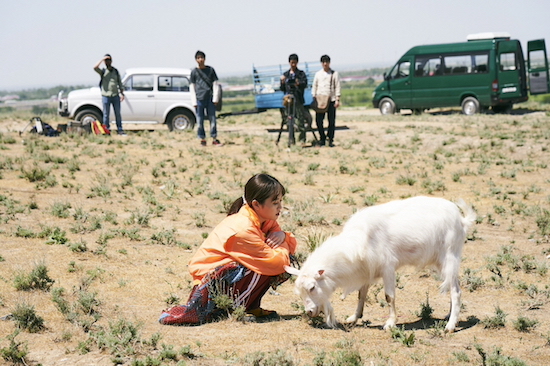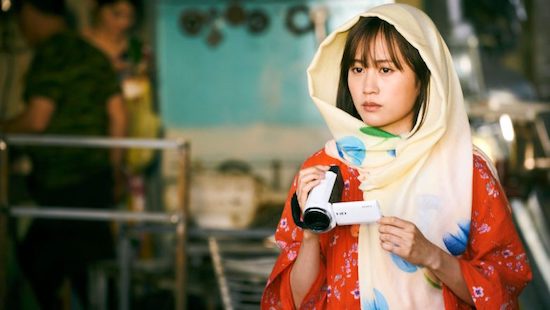Instead of parceling his already lauded work into more polite, tunnel-visioned explorations of a specific theme or mood, Kiyoshi Kurosawa spent much of the 2010s widening his films’ respective purviews. It’s a working method that’s consistently rewarded his longtime champions, and alienated those who think of him exclusively as a more artfully-minded than average horror director. Refusing to fully surrender to the tenets of genre filmmaking, Kurosawa has filtered his own personal preoccupations through the base demands of horror, melodrama, the thriller, and the welcomely messy confluence of all three. The critical peaks of the Japanese director’s career situate themselves somewhere within the late 1990s and early 2000s (where he was hailed as a master of J-horror, even as the touted films transcended such superficial categorization), and precisely in 2008, with Tokyo Sonata, it was embraced as a dramatic divergence into prestige material upon its release.
Attached at the hip with this burgeoning creative restlessness has also been a palpable wanderlust, a two-pronged temperament that finds its cumulative point in Kurosawa’s newest film, To the Ends of the Earth. Commissioned as a commemorative project for the diplomatic relationship between Uzbekistan and Japan, the film follows Yoko (played by popstar Atsuko Madea, who previously starred in Kurosawa’s Seventh Code), the host of a variety television show, as she traipses across the former nation for a laborious location shoot. Effectively opaque, Yoko effortlessly turns on her personable enthusiasm when the cameras are rolling, and slinks back into the kind of blankness that could foresee an emotional breakdown––an intimation suggested by her boyfriend, still in Tokyo, who’s only ever heard over the phone, as well as her own status amongst her all-male crew––that never comes, with the actress perfectly yoking her outward expressiveness to the surrounding environment. Rather than fashion To the Ends of the Earth as a cold exercise in dislocation (of which there’s still plenty), Kurosawa allows for the innumerable sensations engendered by such circumstances to jostle with one another within the foreground.
The comparatively pocket-sized Seventh Code––running a tight 60 minutes––now acts as something of a dry run for To the Ends of the Earth, with Madea adopting a similarly subdued mercuriality as Akiko, a spy of sorts on assignment in Vladivostok, Russia. Kurosawa’s conception of transcontinental espionage is more Jacques Rivette (replete with a visual echo of 1981’s Le pont du nord) than it is Ian Fleming, with any true inkling of discernible plot couched within an equally playful and bloody reveal of intent that comes with only about 15 minutes left in the film. 2017’s Before We Vanish similarly announces itself with the accoutrements of genre in its conceit, only to consistently undercut preconceptions throughout its entirety. In one of the director’s more endearingly obvious––and fitfully grizzly––riffs on John Carpenter’s Starman, an impending alien invasion begins with a few of the extraterrestrials infecting humans with a collective amnesia and even inhabiting their victims’ corporeal forms. One of these hosts used to be young businessman Shinji (Ryuhei Matsuda), whose relative lack of knowledge of planet earth engenders something of a rekindled romance with his wife Narumi (Masami Nagasawa), as the two move across Japan to the predetermined site of invasion, the former’s childlike fascination with concepts such as love and faith bridging the marital fissures that existed before the film.
Before We Vanish is one of the director’s anamorphic widescreen films of the 2010, and although Kurosawa modestly refers to the cinematographic practice as an experiment encouraged by home televisions becoming more accommodating to CinemaScope, his supreme formal acuity still plays as newly invigorated. The aspect ratio is fitting for Before We Vanish, the span of the frame effectively defamiliarizing even the most mundane of spaces, and thus the house shared by Shinji and Narumi can appear just as unnerving as the later, bravura 360-degree pan that plants the viewer in a hospital lobby overburdened with the growing number of victims of the looming invasion.

Similar flourishes abound in ostensible 2016 horror films Creepy and the French-language Daguerreotype, which also capitalize upon their director’s employment of CinemaScope. Kurosawa has often wedded horror with domestic discord, with masterworks such as Cure and Séance populated with families fending off variations of a supernatural threat that compounds their own unnavigable distances between one another. The otherworldly forces gathered in these two films are both simply presented––Creepy hinges on a couple’s neighbor, an embodiment of evil who more than capably earns the titular adjective; Daguerreotype is a ghost story rooted in the archaic photographic process of its own title––even as their respective end goals are entirely surprising. The widescreen freights the negative space with foreboding, even in the most functional of exchanges and scenes: much of what predicts Creepy’s rugpull indulgence of horror in its second half is predicted by seemingly casual, neighbor-to-neighbor exchanges; Daguerreotype takes full advantage of its Parisian manor setting, so that we’re left not wondering if a ghost will show up, but when. As each film continuously circles back to its prevailing “human” elements, the more earthbound drama is what furnishes such affecting results.
At first blush, To the Ends of the Earth may be Kurosawa’s least genre-inflected effort since Tokyo Sonata, but it shares more with peers of its decade than it does with that film’s family drama. Kurosawa’s incisive investigation into, and subsequent interrogation of, liminal states of being over the last decade has followed a sinuous path, one which this newest project admirably tries to singularly embody. The “travelogue” structure of To the Ends of the Earth provides an episodic feel, one in which the overflowing tangents of films prior are now seamlessly incorporated into the larger narrative.
This is attributable to Madea’s performance, an uncoercive means of submerging the audience within this film’s tantalizing opacity. Whether or not the growing frustration and exhaustion of the shoot is occurring solely within each given moment, or originating from something deeper, is largely inscrutable, with Madea prone to fits of both ebullient self-actualization and gnawing alienation. The film often doubles back on itself, offering counterparts to equal examples of both the former and the latter. Yoko finds herself besotted with a villager’s goat, and frees it for a segment she’s authored herself, only for the owner to capture it again; she has to choke down a cold, unfinished dish for a piece on local cuisine, but is given a warm, completed helping after the cameras have stopped rolling. This push-pull relationship between scenes reaches a head when Yoko later finds herself liberated by the opportunity to operate a camera herself, gleefully using the front-facing function as she races through the Chorsu Bazaar, only to then be separated from her crew and pursued by security guards after wandering through a restricted area, a sequence which draws generously from Kurosawa’s horror films, with the guards occasionally cloaked in ominous shadow as the chase moves its way underground.
Throughout, Kurosawa continues to refine his use of widescreen, with durationally impressive takes and rapid cuts that bring to mind the objective style of another protean director, Otto Preminger. Like Preminger, Kuroswa practically flaunts a stubborn withholding of easy interiority and digestible motivation, allowing the perspective-shifting qualities of the camera to play out as gracious footholds. To the Ends of the Earth is at its most formally exciting when following Yoko through the Navoi Theater, offering a progression of quick cuts tracking the actress down the cavernous hallways, her own unspoken ease with her surroundings signaled by the unique editing patterns. Like its more immediate predecessors, To the Ends of the Earth doesn’t possess some overarching formal schema, allowing each character’s relationship with their environment to anchor Kurosawa’s unique creative disposition.


